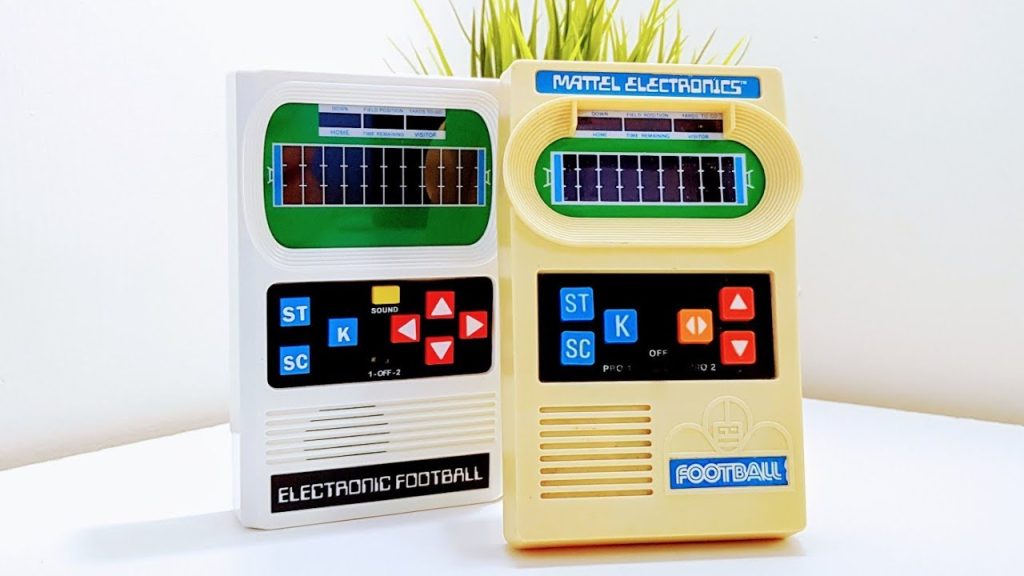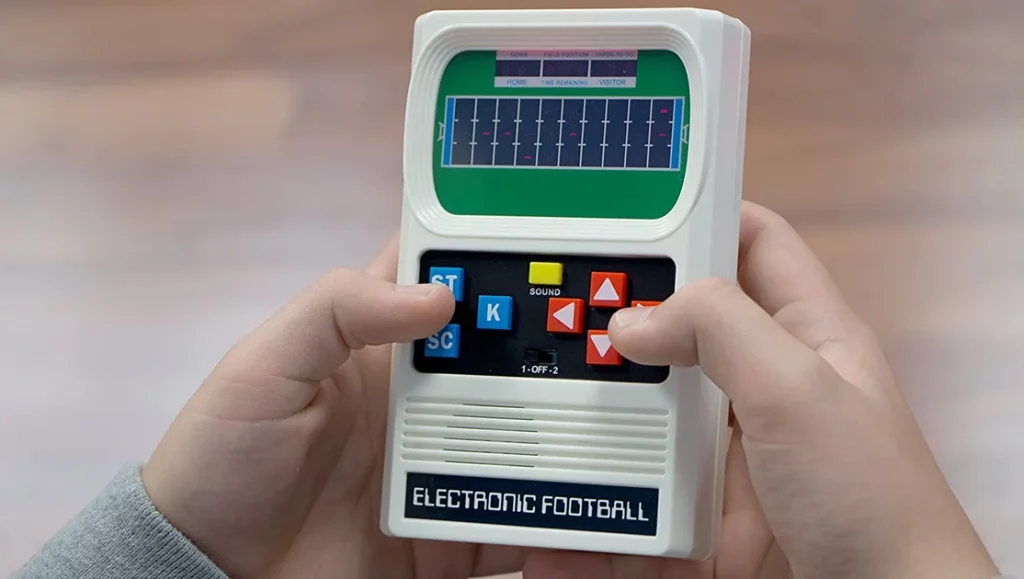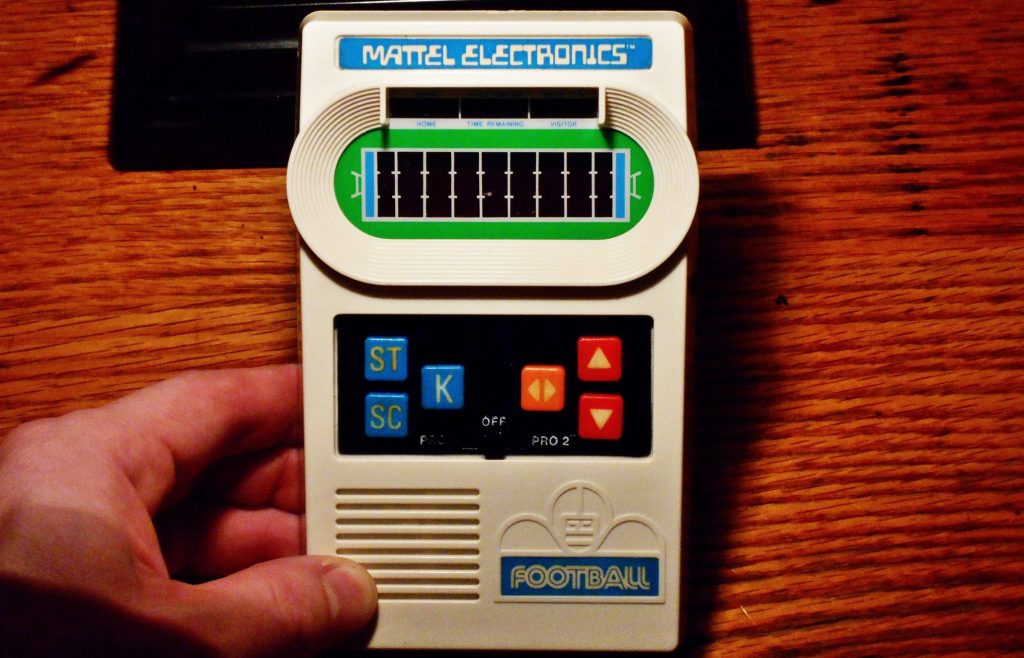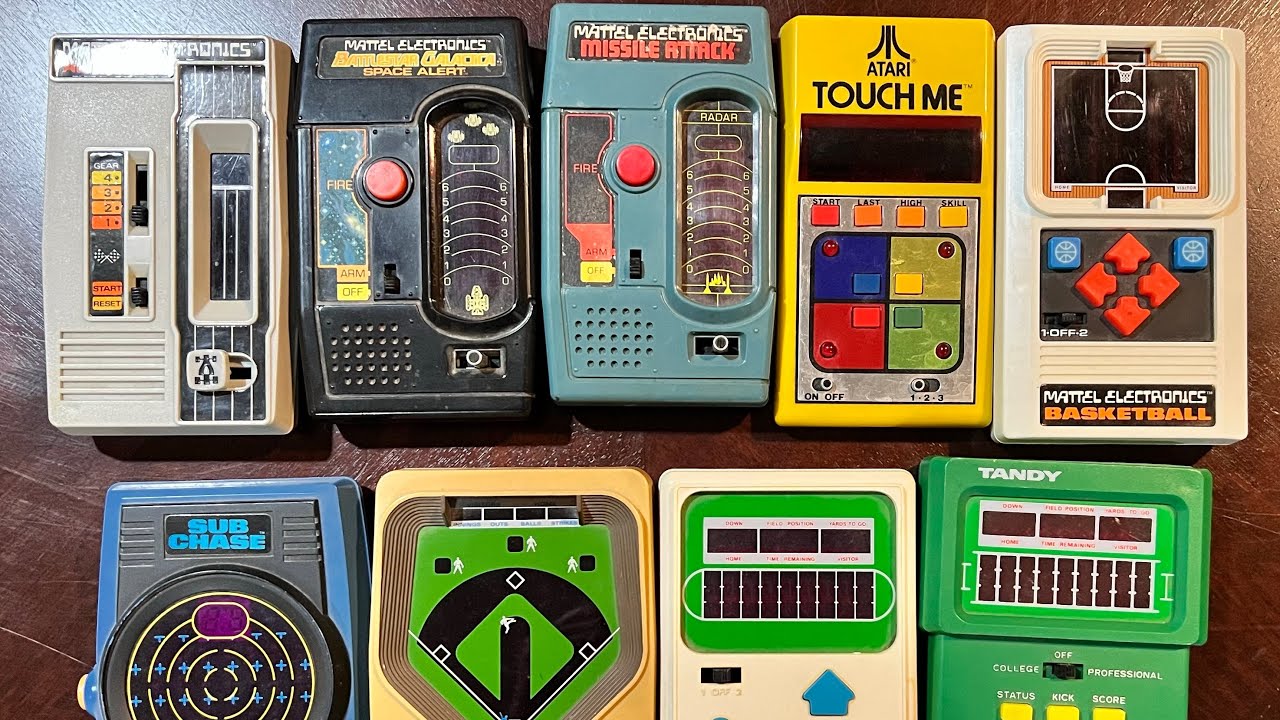Introduction
The Mattel Handheld Football Game is one of the most iconic examples of portable electronic entertainment in history. First introduced in the late 1970s, it quickly became a must-have item for children and teenagers across the United States. At a time when video games were still in their infancy and home consoles were relatively expensive, this simple, battery-powered handheld device brought the excitement of football into the palm of your hand.
The combination of flashing LED lights, straightforward controls, and highly addictive gameplay created a cultural phenomenon that still resonates with retro gaming enthusiasts today. Even decades later, the Mattel Handheld Football Game remains a symbol of an era when gaming was about creativity, imagination, and accessibility rather than graphics and processing power.
The Origins Of The Game
Mattel Electronics, a division of the toy company Mattel, recognized the growing interest in electronic games during the 1970s. At the time, handheld devices were just beginning to emerge as a new category in the toy and game market. Inspired by the rising popularity of sports video games and the public’s passion for American football, Mattel sought to create a game that could capture the essence of the sport while being simple enough to play anywhere.
Released in 1977, the original Mattel Electronic Football was a small, rectangular device powered by a 9-volt battery, with red LED lights serving as the “players” and “football.” Despite its minimalistic presentation, the game offered enough strategic depth to keep players hooked for hours.
Design And Gameplay Mechanics
The Mattel Handheld Football Game’s design was straightforward yet ingenious. The small plastic casing featured a field layout on the display, marked with yard lines and a scrolling LED field that simulated movement down the gridiron. Players controlled a single blinking red light that represented their player, while the opposing team was represented by other red lights moving toward you. The objective was to avoid being tackled while advancing the ball toward the end zone. Once the ball crossed the goal line, the player scored a touchdown.
Movement was controlled by directional buttons that allowed you to dodge defenders and find open lanes. Each game consisted of four quarters, and players had to manage time, downs, and scoring opportunities. The challenge increased as the defenders’ speed accelerated with each level. While the gameplay might sound basic by modern standards, it was incredibly addictive because it required quick reflexes, careful timing, and strategic planning to evade defenders and maximize yardage.

The Cultural Impact Of The Late 1970s
When the Mattel Handheld Football Game launched, it tapped into a growing fascination with electronic entertainment. The late 1970s marked a transitional period in gaming history, with arcade machines becoming popular and home consoles like the Atari 2600 entering the market. However, the portability of the Mattel device set it apart. Kids could play it on the school bus, during recess, or at home without the need for a television or bulky equipment.
Its affordability also made it accessible to a wide range of families. Many parents viewed it as a safer and more wholesome alternative to arcades, and it became a common stocking stuffer during the holiday season. By the end of the decade, Mattel’s handheld games, particularly the football series, had sold millions of units, solidifying their place in gaming history.
Variations And Upgrades Over The Years
Following the massive success of the original game, Mattel introduced several variations and sequels to keep the momentum going. The first major upgrade came in the form of Mattel Electronic Football II, which added more complex gameplay features such as passing plays and a more challenging defensive AI. This new version also offered two-player functionality, allowing friends to compete against each other by taking turns.
In later decades, the handheld football game received various re-releases, often updated with modern technology while preserving the original gameplay. Some versions replaced the LED lights with LCD screens, added sound effects, or featured sleeker, more ergonomic designs. However, collectors and purists often prefer the original LED version for its nostalgic authenticity and simplicity.
The Gameplay Experience And Strategy
While the Mattel Handheld Football Game was easy to pick up, mastering it required skill. Successful players learned to read the movement patterns of the defenders, anticipate their next positions, and plan their runs accordingly. Timing was critical, as rushing forward without paying attention to defender alignment often led to a quick tackle.
On higher difficulty levels, defenders moved faster, forcing players to develop quick reflexes and adapt on the fly. In later versions that included passing mechanics, players had to decide whether to run the ball or attempt a throw, weighing the risks and potential rewards of each approach. This level of decision-making gave the game depth and replay value, ensuring that it never felt repetitive.
The Role Of Nostalgia In Its Continued Popularity
One of the most fascinating aspects of the Mattel Handheld Football Game is how it continues to resonate with players decades after its release. For those who grew up in the 1970s and 1980s, the game represents a simpler time in gaming—free from microtransactions, high-end graphics requirements, or online connectivity. It was an era when gameplay mechanics were the heart of the experience, and your skill alone determined your success.
This nostalgia has fueled a strong collector’s market for vintage Mattel handhelds. Original units in good condition, especially those with their original packaging, can fetch impressive prices among retro gaming enthusiasts. Many adults now purchase the game not just to play, but to relive cherished childhood memories or introduce their own children to a piece of gaming history.

Mattel Handheld Football In Pop Culture
The influence of the Mattel Handheld Football Game extends beyond its initial market success. It has made appearances in films, television shows, and even music videos as a symbol of late 20th-century childhood. The game’s distinctive beeping sounds and flashing LEDs instantly evoke a sense of retro Americana, making it a favorite prop for productions set in the 1970s or 1980s.
In some cases, the game has been referenced in interviews by athletes, celebrities, and game designers who cite it as one of their earliest gaming experiences. It has even inspired modern indie developers to create minimalist sports games that capture the same spirit of stripped-down, skill-based fun.
Modern Re-Releases And Collectors’ Editions
Recognizing the enduring appeal of the Mattel Handheld Football Game, Mattel and other companies have periodically re-released updated versions. These reissues often come with improved durability, battery efficiency, and sound effects while preserving the original LED style that fans love. Some limited editions have been packaged in retro-style boxes, complete with artwork that mirrors the original 1970s design.
In recent years, retro gaming expos and conventions have featured booths dedicated to classic handhelds, allowing attendees to try the game firsthand. This renewed exposure has helped introduce the Mattel Handheld Football Game to a new generation of players who might otherwise never have encountered such a simple yet captivating form of entertainment.
Why Does The Game Still Matters Today?
While technology has advanced dramatically since the late 1970s, the Mattel Handheld Football Game remains relevant because it demonstrates the timeless appeal of good game design. It proves that engaging gameplay does not require complex graphics, vast open worlds, or massive budgets. Instead, it thrives on clear objectives, responsive controls, and the rewarding feeling of mastering a challenge.
The game’s legacy also highlights the importance of portability in entertainment. Long before smartphones allowed people to carry thousands of games in their pockets, Mattel’s handheld devices were providing on-the-go fun with no need for an internet connection or charging cable. This self-contained nature made them dependable companions for road trips, long waits, or quick play sessions between activities.
The Mattel Handheld Football Game As A Collector’s Item
For collectors, owning an original Mattel Handheld Football Game is about more than nostalgia—it’s about preserving a piece of gaming history. The earliest models, particularly those in mint condition, are highly sought after in the vintage electronics market. Collectors look for original packaging, instruction manuals, and working conditions, as these factors significantly affect the item’s value.
The collector’s appeal is also tied to the broader retro gaming movement, which values simplicity and authenticity in an age of increasingly complex technology. As a result, the Mattel Handheld Football Game is often displayed alongside other vintage electronic toys, such as Simon, Speak & Spell, and Coleco’s handheld sports games, forming a curated tribute to the golden age of portable gaming.

Educational And Historical Significance
Beyond its entertainment value, the Mattel Handheld Football Game has educational and historical importance. It serves as a snapshot of late 20th-century design and engineering, showing how developers worked within strict technological limitations to create compelling gameplay. The use of LED lights to simulate player movement was innovative for the time and paved the way for more advanced handheld gaming systems in the years that followed.
For those studying the history of video games, Mattel’s handheld devices are a key chapter in the transition from mechanical and board games to fully electronic, interactive entertainment. They represent a bridge between the pre-digital toy market and the home console revolution that would soon dominate the industry.
The Future Of Retro Gaming And Handheld Football
As retro gaming continues to thrive, the Mattel Handheld Football Game is poised to remain a fixture in discussions about the origins of portable gaming. While it is unlikely to compete with modern mobile games in terms of widespread popularity, its cultural significance ensures that it will be preserved and celebrated by enthusiasts for years to come.
Digital emulations and app-based recreations have already emerged, allowing players to enjoy the classic gameplay on smartphones and tablets. However, many purists argue that the tactile feel of the original device—the click of the buttons, the glow of the LEDs, and the size of the handheld—cannot be fully replicated on a touch screen. For them, the true experience comes from holding the real thing.
Conclusion
The Mattel Handheld Football Game is more than just a toy; it is a cultural artifact that represents a turning point in the history of electronic entertainment. Its success in the late 1970s and beyond demonstrates the enduring power of simple, engaging gameplay combined with clever design. Decades after its debut, it continues to inspire nostalgia, spark conversations about the roots of gaming, and remind us that great ideas often emerge from working within limitations. Whether cherished as a collector’s item, enjoyed as a piece of personal history, or discovered anew by younger generations, the Mattel Handheld Football Game remains a touchstone in the world of portable gaming.

